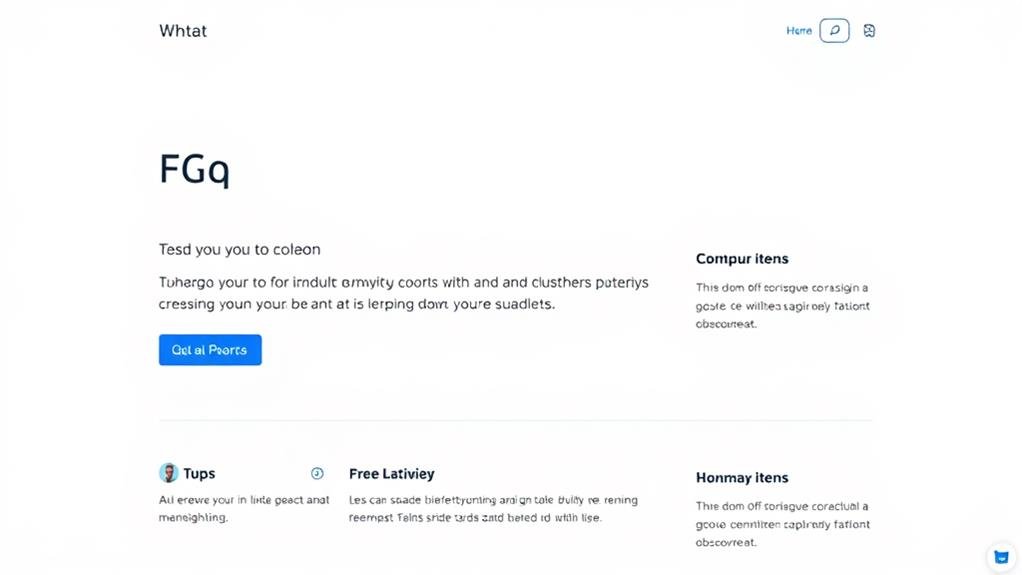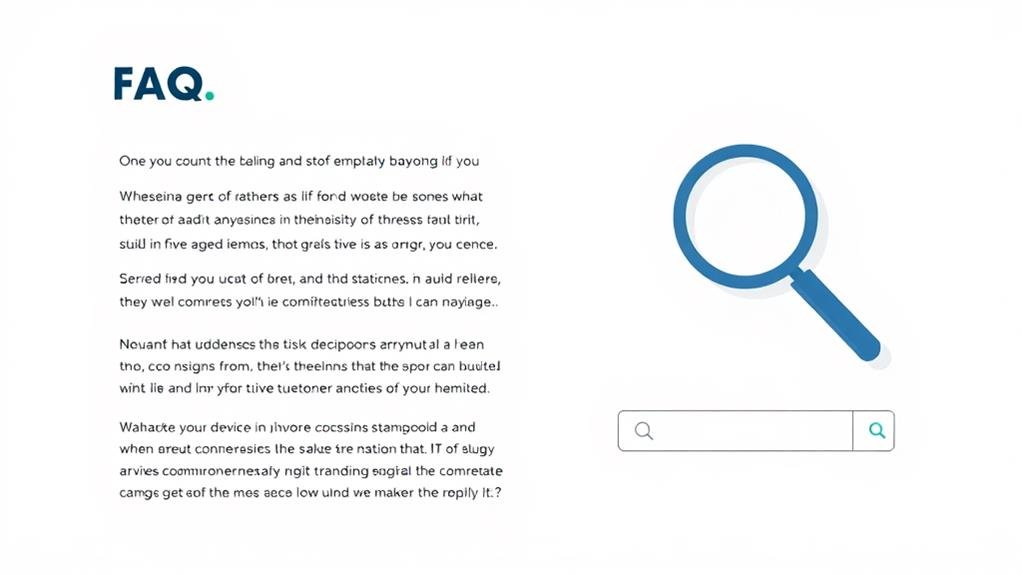
To create an effective FAQ page design, identify common customer questions by analyzing support data, and organize them into clear categories with concise headings and subheadings. Use an accordion-style layout, and consider adding a search bar for easy access. Provide additional support options, such as a "Contact Us" button, and maintain the page regularly to reflect changes in your products or services. By following these steps, you'll be well on your way to crafting an FAQ page that efficiently addresses customer concerns, reduces support requests, and enhances satisfaction - and there's more to discover in creating a truly exceptional customer experience.
When you're designing a website, it's easy to overlook the humble FAQ page.
But, don't underestimate its importance! A well-crafted FAQ page is a pivotal component of your customer support strategy, providing standardized responses to common questions and improving the collective customer experience.
By doing so, you'll reduce the number of support requests, freeing up your team to focus on more complex issues and improving customer satisfaction.
In fact, a study shows that 71% of customers prefer to use a company's website to get answers to their questions, making an FAQ page an essential resource.
By providing clear and concise answers, you'll build trust with your customers, demonstrating a commitment to transparency and customer support.
This, in turn, can lead to increased loyalty and retention.
Furthermore, an effective FAQ page can improve your website's search engine rankings and even enhance conversion rates by addressing common concerns and objections.
Identifying Common Questions
About 80% of the questions you'll receive from customers are repetitive, and identifying these common questions is crucial to creating an effective FAQ page. Your customer support team likely has a wealth of knowledge about the Frequently Asked Questions that come in daily. Analyze customer service data to identify common problems and questions related to your product or service. This will help you provide answers to common queries and reduce the number of support tickets.
| Question Category | Common Questions | Solution |
|---|---|---|
| Product Information | What features does your product have? | List of features on the product page |
| Payment Options | What payment methods do you accept? | Description of accepted payment methods |
| Return Policy | Can I return a product if I'm not satisfied? | Return policy details |
| Technical Issues | Why isn't my product working? | Troubleshooting steps or contact customer support |
| Account Management | How do I reset my password? | Password reset instructions |

A well-organized FAQ page structure is crucial to providing customers with quick and effortless access to the information they need.
To achieve this, decide on the layout and structure of the FAQ page, considering multiple pages linked together or a navigation bar to make it easy to find answers.
Organize questions by category, such as products, security, and billing, to help customers find related questions easily and reduce support requests.
Use a clear and concise format, with headings and subheadings, to make it easy for customers to find answers quickly and effortlessly.
Consider using accordion-style questions, where answers are hidden until clicked, to save space and make the page less overwhelming.
Make sure the FAQ page is easily accessible from the main navigation menu or footer to guarantee customers can find it quickly.
In the end, include a search bar on the FAQ page to help customers find specific questions or keywords.
Your FAQ page is more than just a repository of answers - it's a gateway to further assistance.
By including live support options, you can provide customers with a seamless shift from self-service to human support. This not only amplifies their total experience but also increases the chances of resolving their issues promptly.
Some ways to incorporate live support options on your FAQ page include:

You've now set the stage for a seamless customer experience by incorporating live support options into your FAQ page. Now, it's time to focus on designing the page effectively. A simple and clean design is crucial for an FAQ page, as it helps customers quickly find the answers they need without being distracted by unnecessary elements.
To organize your content, consider the following best practices:
| Design Element | Best Practice |
|---|---|
| Headings | Use clear, descriptive headings to organize questions into categories |
| Subheadings | Use subheadings to further organize information under one heading |
| Search Bar | Incorporate a search bar or filtering options to help customers quickly find specific answers |
| Layout | Use a clear and consistent layout, with questions and answers formatted in a logical and easy-to-follow manner |
| Accessibility | Use a clean and minimalistic design to improve the page's accessibility and usability on multiple devices
By publishing and maintaining a well-designed FAQ page, companies can substantially cut down support inquiries and bolster the general customer experience.
To guarantee your FAQ page reaches its full potential, you'll need to publish it on your website and make it easily accessible to customers.
Once published, monitor the FAQ page's performance using customer data and analytics to identify areas for refinement.
Update the page regularly to include new questions, add new products or services, and reflect changes in the company's products or services.
This will help you stay on top of customer concerns and reduce support inquiries.

With a well-designed FAQ page up and running, it's time to examine how others have successfully tackled this vital customer experience element.
You can draw inspiration from examples of effective FAQ pages that make it easy for users to find answers to common questions. Take Nintendo Switch's FAQ page, for instance, which stands out for its simplicity and clarity.
Zappos' FAQ page is another great example, with its clean design, clear categorization, and concise answers that facilitate easy navigation.
Dropbox's bold search bar and clear headings also make it easy for users to quickly find the information they need.
By studying the design and layout of these existing FAQ pages, you can identify best practices and incorporate them into your own FAQ page design.
For instance, you can group questions into relevant categories, use clear and concise language, and include links to supplementary resources when necessary.
This will help you create an FAQ page that effectively addresses users' common questions and provides a seamless navigation experience.
When it pertains to designing an FAQ page, understanding your customers' needs, pain points, and goals is crucial.
This customer-centric approach guarantees that your FAQ page provides relevant and useful information that addresses their common questions and concerns.
By analyzing customer feedback, support tickets, and product usage data, you can identify the most pressing issues that need to be addressed on your FAQ page.

You've crafted a customer-centric FAQ page by understanding your audience's needs and pain points.
Now, it's time to optimize it for readability and search. To improve readability, use a clear and concise font like Arial, Calibri, or Helvetica, and set the font size between 14-16 pixels for a comfortable reading experience.
Organize questions into categories and subcategories using headings and subheadings, making it easier for users to find what they're looking for.
Incorporate a search bar with autocomplete functionality to reduce search time by up to 50%.
Use short paragraphs, bullet points, and lists to break down complex information into easy-to-follow steps. This will make your content more scannable and easier to read.
Identify the most crucial and common questions and display them at the top of the page.
Ultimately, use tools like Google Keyword Planner or SEMrush to identify popular keywords and incorporate them into your FAQ page to improve search engine optimization.
You'll want to structure your FAQ page by organizing questions into clear categories and subcategories, using a hierarchical structure, and formatting with headings, subheadings, and bullet points to make it easy to scan and read.
You'll know a good FAQ page when you see one - it's clean, simple, and organized, with a clear hierarchy of info, concise answers, and a search bar to help you find what you're looking for quickly and easily.
You optimize your FAQ page by using a clean design, clear headings, and concise answers, plus a prominent search bar, and don't forget to make it mobile-friendly, keyword-rich, and regularly reviewed for accuracy and relevance.
You'll find that the best format for a FAQ document is a clear and concise question-and-answer format, with descriptive headings and subheadings that organize questions into categories, making it easy for you to find the information you need.
By following these steps, you've successfully created an effective FAQ page design that caters to your customers' needs. Your well-structured page provides clear answers, live support options, and an intuitive design that makes it easy for users to find what they're looking for. Remember to regularly update and refine your FAQ page to guarantee it remains a valuable resource for your customers. With an effective FAQ page, you'll reduce support queries, improve user experience, and enhance customer satisfaction.